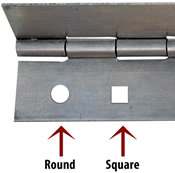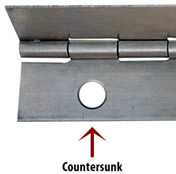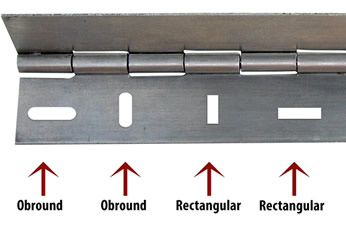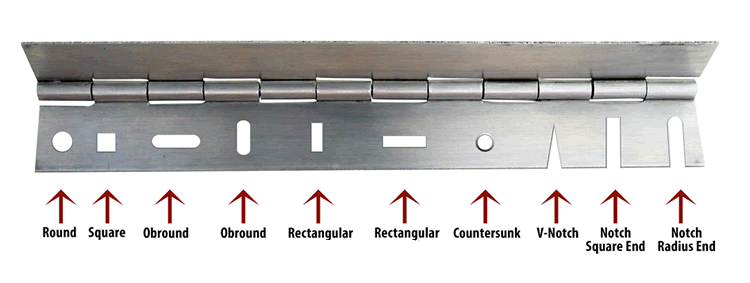Types of Hinge Mounting Holes 
Regardless of the type of mounting hole or opening you have on a hinge, the location to each other and the edges and ends of the hinge are important. Once you get the opening in the right spot you can decide how to size it for the application. This is a brief discussion of each hinge mounting hole or opening style and their applications.
Round and Square Holes
 These are the most common because they offer the greatest contact between the fastener head and the surface of the hinge, as long as the size of the hole is matched to the fastener correctly. Making a hole bigger to address tolerance concerns must result in an adjustment to your fastener size; there is always a “sweet spot” where the hole size, fastener, and control of location result in a working part. Round and square holes require some engineering in design. Sometimes finding the sweet spot is just not possible.
These are the most common because they offer the greatest contact between the fastener head and the surface of the hinge, as long as the size of the hole is matched to the fastener correctly. Making a hole bigger to address tolerance concerns must result in an adjustment to your fastener size; there is always a “sweet spot” where the hole size, fastener, and control of location result in a working part. Round and square holes require some engineering in design. Sometimes finding the sweet spot is just not possible.
Countersinking / Counterboring Holes
 This is putting a chamfer or lead in on the outside edge of the hole. It can have two purposes. One would be to have the fastener head fit flush with the surface, the other would be to ease entry of the fastener while at the same time getting a very positive contact surface and location. Counterboring more often refers to a much thicker style of hinge where the hole is enlarged at the top to make a large headed fastener like a bolt sit flush.
This is putting a chamfer or lead in on the outside edge of the hole. It can have two purposes. One would be to have the fastener head fit flush with the surface, the other would be to ease entry of the fastener while at the same time getting a very positive contact surface and location. Counterboring more often refers to a much thicker style of hinge where the hole is enlarged at the top to make a large headed fastener like a bolt sit flush.
Round End and Square Slots
 These allow movement of the hinge relative to it’s mating surface to adjust the final fit. Less of the fastener actually contacts the hinge leaf and the resulting connection is not as strong. Engineers usually will use more slots than holes to make up for that. The slots can be aligned in any axis to allow direction in any direction, but only back and forth in that direction. You will see slots in a lot of consumer assembled products. These types of hinges are forgiving.
These allow movement of the hinge relative to it’s mating surface to adjust the final fit. Less of the fastener actually contacts the hinge leaf and the resulting connection is not as strong. Engineers usually will use more slots than holes to make up for that. The slots can be aligned in any axis to allow direction in any direction, but only back and forth in that direction. You will see slots in a lot of consumer assembled products. These types of hinges are forgiving.
V, Square, and Round End Notches
 A v notch does a nice job of positively locating a part and is easy to line up if you push the part tight to the top of the V. Square and Round end notches work the same way but allow more movement. Notches are the lowest strength of any of the attaching methods for continuous hinge, but are very forgiving in speed and ease of installation.
A v notch does a nice job of positively locating a part and is easy to line up if you push the part tight to the top of the V. Square and Round end notches work the same way but allow more movement. Notches are the lowest strength of any of the attaching methods for continuous hinge, but are very forgiving in speed and ease of installation.

Monroe produces continuous hinges and can produce them in any length with any type
Are you looking for hinges?
Submit an RFQ now!
